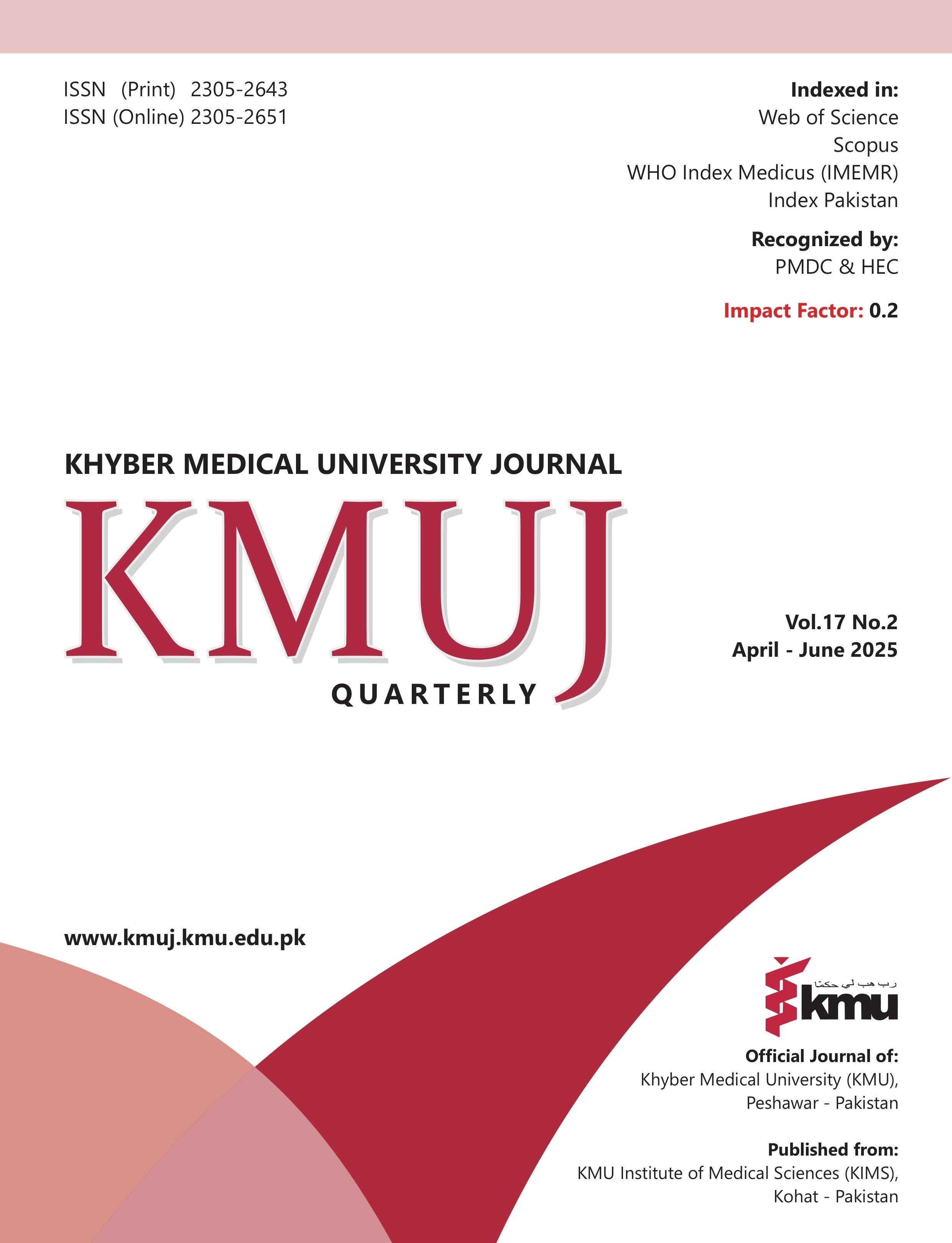Parental knowledge and preventive role in child abuse: a cross-sectional study from a tertiary care hospital in Pakistan
Main Article Content
Abstract
Objective: To assess the knowledge, attitudes, and preventive role of parents regarding child abuse (CA), and to identify factors influencing parental awareness in a tertiary care hospital setting in Pakistan.
Methods: This cross-sectional study was conducted at Mayo Hospital, King Edward Medical University, Lahore, Pakistan, from January to September 2022. A total of 114 parents of children aged ≤12 years were enrolled through non-probability convenience sampling. Data were collected using a pre-validated, bilingual (English and Urdu) self-administered questionnaire, adapted with permission. Demographic variables and responses to Likert-scale items assessing parental knowledge and practices related to child abuse prevention (CAP) were analyzed using SPSS v26. Chi-square test was applied to assess associations, with p<0.05 considered statistically significant.
Results: The mean age of respondents was 33.7±6.5 years; 60.5% were mothers. Most participants (91.2%) lived in two-parent households. While 89.5% agreed that educating children about CAP is essential, only 68.1% had discussed CAP with their children. The mean age of children suggested for CAP education was 5.9±2.3 years. Knowledge gaps were observed, especially regarding physical signs of abuse and misconceptions about perpetrators. Significant associations were found between demographic variables (age, education, income) and CAP-related beliefs (p<0.05). Only 5.3% reported their child had participated in a formal CAP program.
Conclusion: Although parents recognize the importance of child abuse prevention, actual engagement in preventive education remains suboptimal. Efforts should focus on structured CAP programs and parent-targeted interventions, especially in families with younger children or limited education.
Article Details

This work is licensed under a Creative Commons Attribution 4.0 International License.
Work published in KMUJ is licensed under a
Creative Commons Attribution 4.0 License
Authors are permitted and encouraged to post their work online (e.g., in institutional repositories or on their website) prior to and during the submission process, as it can lead to productive exchanges, as well as earlier and greater citation of published work.
(e.g., in institutional repositories or on their website) prior to and during the submission process, as it can lead to productive exchanges, as well as earlier and greater citation of published work.
References
1. Promoting research to prevent child maltreatment. Istanbul, turkey. XIXth International congress on child abuse and neglect. September,2012;2,5. Accessed on: May 04, 2025. Available from URL: https://www.who.int/violence_injury_prevention/violence/child/ispscan_report_june2013.pdf
2. Bano M. SAHIL Cruel Numbers 2024: A compilation of statistics on child sexual abuse reported cases in Pakistan. Accessed on: May 04, 2025. Available from URL: https://drive.google.com/file/d/1BiZQB4r46gbIYR88plzov08iuLzJ606_/view
3. Prevent child abuse -America. Prevention programs: An approach to prevent child abuse. Accessed on: November 15, 2021. Available from URL: https://preventchildabuse.org/resource/an-approach-to-prevent-child-abuse/
4. Daro D, Donnelly AC. Child abuse prevention: accomplishments and challenges. In Myers JEB, Berliner L, Briere J, Hendrix CT, Jenny C, Reid TA (Eds.), The APSAC handbook on child maltreatment. 2002;2nd Ed:431-48. Sage Publications, Inc.
5. 4. Cicchetti D. Socioemotional, personality, and biological development: Illustrations from a multilevel developmental psychopathology perspective on child maltreatment. Ann Rev Psychol 2016;67:187-211. https://doi.org/10.1146/annurev-psych-122414-033259
6. Zeanah CH, Humphreys KL. Child abuse and neglect. J Am Acad Child Adolesc Psychiatry 2018;57(9):637-44. https://doi.org/10.1016/j.jaac.2018.06.007
7. Teicher MH. Adoptee rage. The wounds that time won’t heal-the neurobiology of child abuse. December 22, 2015. Accessed on: November 15, 2021. Available from URL: http://adopteerage.blogspot.com/2015/12/the-wounds-that-time-wont-heal.html
8. Devi AK, Mrs. Yadav R. Knowledge regarding child abuse among parents. Int J Adv Nurs Management 2016;4(3):191-3. https://doi.org/10.5958/2454-2652.2016.00044.5
9. Burgess ES, Wurtele SK. Enhancing parent-child communication about sexual abuse: A pilot study. Child Abuse Negl 1998;22:1167-75. https://doi.org/10.1016/s0145-2134(98)00094-5
10. Tucci J, Mitchell J. Still Unseen Ignored:Tracking community knowledge and attitudes about child abuse and child protection in Australia. August 2021. Australian Childhood Foundation. Accessed on: April 08, 2025. Available from URL: https://www.childhood.org.au/app/uploads/2021/08/Still-unseen-and-ignored-report-FINAL-REPORT-17aug21.pdf
11. United Nations Educational, Scientific and Cultural Organization (UNESCO). International Technical Guidance on Sexuality Education. The rationale for sexuality education. December 2009. Accessed on: March 01, 2025. Available from URL: https://unesdoc.unesco.org/ark:/48223/pf0000183281/PDF/183281eng.pdf.multi
12. Dixon-Mueller, R. How Young is “Too Young”? Comparative perspectives on adolescent sexual, marital, and reproductive transitions. Stud Fam Plann 2008;39(4):247-62.
13. Wang M, Lwin MO, Cayabyab YMTM, Hou G, You Z. A Meta-analysis of factors predicting parental mediation of children’s media use based on studies published between 1992–2019. J Child Fam Stud 2023;32:1249-60. https://doi.org/10.1007/s10826-022-02459-y
14. Ahmed M. Child Abuse in Pakistan: Understanding the Crisis and Seeking Solutions. British Pakistani Index. Accessed on March 30, 2025. Available from URL: https://pakistaniindex.org/2024/05/child-abuse-in-pakistan-understanding-the-crisis-and-seeking-solutions/
